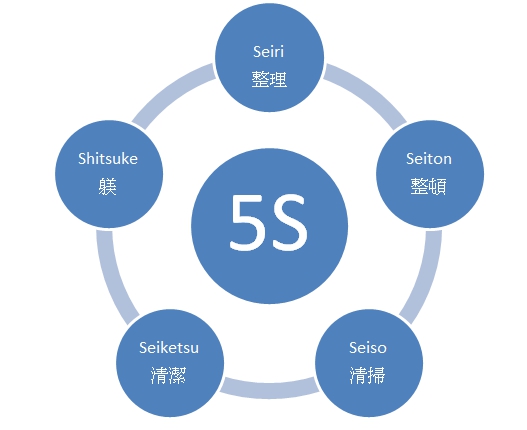This Japanese method for creating workplace excellence requires active involvement of each employee.
How to implement and sustain the Japanese method of 5S
This Japanese method for creating workplace excellence requires active involvement of each employee
Rama Krishna Thadaka
The workplace is the sanctum sanctorum of an organisation— where one works, where value is added to the products or services, and where profits are generated.
An excellent workplace is a workplace ‘where what is supposed to happen does happen on time, every time and as per the standard procedure’.
The Japanese method for workplace excellence, 5S, stands for five components— SEIRI (Sort), SEITON (Systematic Arrangement), SEISO (Spic and Span), SEIKETSU (Standardisation) and SHITSUKE (Sustain)
Although 5S is well appreciated in India, most of the organisations that have initiated 5S are facing difficulty in either implementing or to sustaining the same.
Critical Success Factors for implementation and sustenance of 5S
1. Objective of 5S: No new initiative will survive for long without a clearly-defined objective. The same is true for 5S also. The objective of implementing 5S in the organisation should be clearly defined and understood by the top management. If 5S is being implemented for the sake of implementation or due to competition or for the sake of the company’s image in the society, then it will not survive for long time. Ideally, there should be a 5S Vision for the organization with clear objectives and targets in terms of audit scores and returns.
2. Top management commitment: A long-term top management commitment is essential. A continuous drive, support to the middle and junior management and periodic involvement of top management in 5S activities at the shop floor will make 5S successful in the organisation. 5S will suffer a premature death if the top management loses interest and stops monitoring the progress. As carrying out 5S involves a cultural change in the organisation, it is very difficult to restart the implementation process if it is interrupted by any means.
3. Second priority: 5S may take a backseat in middle- and junior management priorities, if the top Management gives second priority to it. Like other management initiatives, 5S also takes some time to reap results. These results must be considered as long-term repercussions and management should give equal priority to initiatives resulting in short-term and long-term results.
5S, stands for five components— SEIRI (Sort), SEITON (Systematic Arrangement), SEISO (Spic and Span), SEIKETSU (Standardisation) and SHITSUKE (Sustain)
4. Old paradigm: Some of the employees, even at the middle management level may question the need for 5S since they feel they are doing well. It is essential to address such doubts. The top management, in particular, should make them understand the need of 5S and total employee involvement in 5S.
5. Resistance to change: The law of inertia is true for human beings — they do not readily accept change. As employees consider status quo as their comfort zone, it is the top management’s responsibility to disturb this comfort zone and setup a new comfort zone through transit. This process resembles the PDCA cycle.
6. Investment and returns: 5S requires some investment in the initial stages of implementation. Top management should understand that the return on investment may take a long time but the rate of returns will be high. Therefore, they should not be tempted to abandon the implementation in the middle thinking that there is no RoI in the short term.
7. Additional responsibility: Some of the employees may perceive 5S as an additional responsibility beyond their routine job. It is management’s responsibility to make all employees understand that 5S actually helps to ease their routine job activities and is not an additional job.
8. Ownership by employees: Some employees may feel that they work for money and that the company pays them salary to do their routine job. They also feel that the management is the owner of the workplace and employees are just hired to work there. It is very important to create a sense of ownership among all the employees so that they feel part of the development of their workplaces. Only then will they be they be effectively and efficiently involved in 5S.
9. Rewards system: A suitable recognition and rewards system will motivate employees to actively participate in 5S implementation and sustenance. A proper recognition and rewards system will develop positive competition among employees to involve them actively in implementation and sustenance.
10. Publicity and Communication: Effective publicity and communication will motivate employees to buy the concept, believe in it and involve themselves in its implementation. Communication highlighting the benefits of 5S to the employees as well as the organisation will encourage the employees to consider 5S and get involved in it.
11. Misunderstanding of 5S concept: Some employees may understand 5S as a housekeeping activity and assume that their role is minimal in its implementation and sustenance. In realilyt, while housekeeping does form a part of 5S, it does not imply housekeeping alone. 5S needs every employee’s active participation, involvement and innovativeness.
12. Training and handholding: Training and handholding by experts will help organisations introduce 5S. If the top management happen to be inexperienced, they can seek the help of external experts in developing an implementation strategy, a roadmap and related policies. A significant barrier for effective 5S implementation is poor training and awareness of employees.
13. Total employee involvement: 5S can be implemented in an effective and efficient way only by involving everyone in the organisation. No employee, irrespective of position and function, can be excluded from 5S implementation. An involved employee will only care for its sustenance. Those not involved in implementation process may not care for sustenance and end up adversely affecting those involved.
14. Continuous activity: It is necessary for all employees in the organisation, irrespective of their level, to understand that 5S is not a project but a set of practices ensuring continuous improvement activities that are to be made part and parcel of their routine jobs. They also need to understand that there is no limit for excellence
15. Change in management: Frequent change of employees at the top and middle management levels can hinder smooth implementation. New employees may take time to understand and cope up with the concept of 5S.
16. Slow/ fast pace of implementation: 5S shapes organisation culture. Here, culture can be understood as a sum of occupational habits of employees working in the organisation. Changing occupational habits of employees may take time. The time frame for implementation should be optimised on the basis of the size and culture of the organisation. Fast pace of implementation can lead to confusion among employees and end up being a burden on their routine. Slow pace may, on the other hand, end up demotivating the employees.
17. Focus on audits: Gemba Walk Audits (Visiting the workplace) by top Management and resolving of workplace issues on the spot can motivate employees to participate more actively. Regular and periodic internal and external audits will help sustain 5S.
18. Set example: The top and middle management should implement 5S and showcase good occupational habits in their own workplaces to set an example for their subordinates.
19. Certifications / competitions: Arranging inter-zonal and inter-plant competitions and participation in external competitions makes employees assess their status in implementation and benchmark themselves with other organisations
20. Implementation Strategy: A customised 5S implementation strategy based on the prevailing culture, size of the organisation and type of process (manufacturing or service, continuous process or batch) makes implementation easy. The strategy should not be copied, as it is, from other companies.
These are only some of the critical factors for successful implementation of 5S
The author is a chemical engineer and a practising HR manager with Deepak Nitrite, Vadodara.
Value our content... contribute towards our growth. Even a small contribution a month would be of great help for us.
Since eight years, we have been serving the industry through daily news and stories. Our content is free for all and we plan to keep it that way.
Support HRKatha. Pay Here (All it takes is a minute)




































